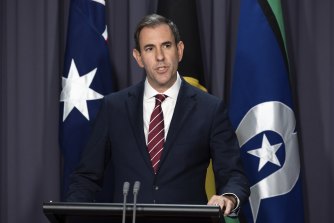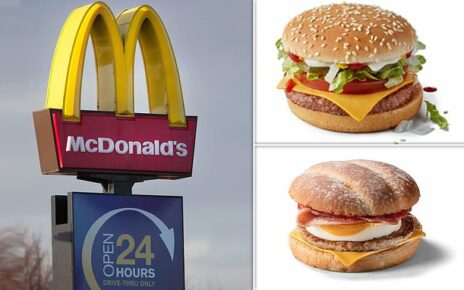The Reserve Bank could lift rates even higher than tipped on Tuesday after Treasurer Jim Chalmers said inflation was worse than the March budget forecast as prices for essentials, including food and petrol, continue to rise.
The RBA is expected to hike the official cash rate by at least a quarter percentage point on Tuesday, but financial markets say there’s a three in four chance it will increase the rate by 0.4 percentage points to address inflation. AMP chief economist Shane Oliver said there was a chance of a 0.5 percentage point increase.
Treasurer Jim Chalmers said the inflation figure could be “significantly higher” when it’s updated for his statement to parliament.Credit:Alex Ellinghausen
The RBA lifted interest rates during the election campaign from historic lows to 0.35 per cent, amid signs wages growth was heating up and inflation increasing at levels not seen since the introduction of the GST. Australian Bureau of Statistics data from March showed inflation grew 5.1 per cent in the 12 months to March and 2.1 per cent in the first three months of the year.
While the next official figures won’t be published until the end of July, Chalmers flagged inflation would outpace the Coalition’s budget forecast of 4.25 per cent through the year to June.
“There’s no use mincing words here, the inflation we inherited is high and rising, and real wages are falling faster than they have at any point in the last two decades,” he said.
“I’m likely to update the inflation forecasts in my statement to the parliament when it returns, in advance of a full update in the October budget, and that number could be significantly higher.”
Growing costs of essentials including petrol and fresh food helped drive inflation, with essential goods and services increasing by 6.6 per cent over the past year.
Experts have warned the price of staples, including fresh vegetables, bread and meat, will continue to rise due to ongoing supply chain pressures.
Australians are also having to brace for looming power price rises due to soaring fossil fuel costs. Average petrol prices for the last week of May reached $2 a litre, rising oil prices eating up the 22 cents a litre fuel tax relief, which is set to end in September.
Amid a gas supply crisis, freezing temperatures in Sydney and Melbourne led to a forecast spike in wholesale prices of more than 50 times normal levels last week, forcing the Australian Energy Market Operator to intervene and set a price cap. Federal and state governments will meet this week to address the supply crunch.
The RBA considered a 0.4 percentage point hike in May but instead opted for a smaller increase. Since the May meeting, wages data proved softer than expected but business contacts have told the RBA wages growth is accelerating, and March quarter economy data showed GDP growth was strong.
Oliver said inflationary pressures continue to mount, “notably with a rebound in petrol prices and reports of surging power prices and rents”.
“As a result, RBA concerns about rising inflation psychology are likely to have increased arguments for a step-up in the pace of tightening in June in order to get on top of inflation – just as we have been seeing in New Zealand, Canada and likely soon in the US,” he said.
“And so we expect a 0.4 per cent hike taking the cash rate to 0.75 per cent. There is a risk it could even opt for a 0.5 per cent hike.”
Across NSW, the average new home loan has reached $800,000 while in Victoria it is now at $650,000, meaning even a small increase in interest rates will deliver financial pain to stretched borrowers.
Oliver said the recent downturn in the property market, with house prices falling 0.1 per cent in May, was good news for the RBA as it showed the central bank’s moves were getting traction.
UBS economists expect the RBA to lift the cash rate by 0.25 percentage points but say there’s a chance of a 0.4 percentage point rise.
They said inflation, which UBS expects to rise further, the upcoming minimum wage decision due from the Fair Work Commission by the middle of June and quick interest rate moves from other central banks will add pressure to the RBA.
“The RBA will keep an urgency to hike in coming months,” the UBS economists said.
“We expect the RBA to reiterate ‘soft forward guidance’ they are ‘committed to doing what is necessary to ensure that inflation in Australia returns to target over time. This will require a further lift in interest rates’.”
Cut through the noise of federal politics with news, views and expert analysis from Jacqueline Maley. Subscribers can sign up to our weekly Inside Politics newsletter here.
Most Viewed in Politics
From our partners
Source: Read Full Article


